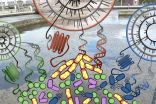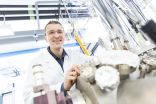(Press-News.org) The Luxembourg Centre for Systems Biomedicine (LCSB) has succeeded for the first time in describing the complex relationships within an ecosystem in unprecedented detail. For their work, carried out in collaboration with US and Luxembourg partners, their model ecosystem was a "biological wastewater treatment plant". In it live numerous species of bacteria which are involved in the wastewater purification process.
LCSB director Prof. Dr. Rudi Balling stresses the medical importance of these research efforts: "Bacterial ecosystems also play a major role in our health. We now have a better understanding of the laws governing their function." The researchers publish their results today in the journal "Nature Communications" (DOI: 10.1038/ncomm6603).
With their findings, the LCSB group of Prof. Dr. Paul Wilmes, head of the LCSB group "Ecosystems Biology" and ATTRACT-fellow of the Luxembourg National Research Fund (FNR), corroborate and unify various ecological concepts that have been primarily formulated based on observations in macrobiotic systems such as forests, rivers and oceans - which cannot however be experimentally investigated in depth because of the sheer size of these biotopes. For their analyses of the treatment plant ecosystem, the researchers employed Systems Biology methods. Wastewater destined for treatment comprises energy-rich substrates including fats, proteins, carbohydrates and many other substances that serve as nutrients for the resident bacteria. Every wastewater treatment plant is therefore a complex ecosystem. Countless bacterial species adapt to the living conditions in the water, compete for resources and each find a niche in which they can best survive.
"The techniques developed at LCSB allow us now to unravel these processes very precisely at the molecular level," says Dr. Emilie Muller, first author of the publication. The basis for this are the so-called "omics" - genomics, transcriptomics, proteomics and metabolomics - combined with new bioinformatic methods for integrated data analysis. "With these, we can determine from samples which organisms are living in the treatment plant, and what their population sizes, genetic make-up, activities and material turnovers are like.
Therefore, there is no longer any need to study bacteria separately in pure cultures," Muller explains: "Based on this, we can ultimately model the material flows in the 'treatment plant' ecosystem and describe, for example, which bacterial species will use and consume which substrate and to what degree."
Yet Emilie Muller wants to go further than simply modelling the wastewater treatment plant ecology: "We want to understand what factors determine the species composition and accordingly the balance in the ecosystem." In this context, there is one species of bacteria that stands out and has grabbed the researchers' attention: Microthrix parvicella, whose genome sequence the LCSB group first decrypted two years ago. This bacterium can absorb and store an especially large amount of lipids. In winter, up to 50 percent of all bacteria on the surface of treatment tanks belong to this species.
Emilie Muller continues: "That is rather astonishing, given that the amount of lipids in the wastewater is rather low in winter, and Microthrix actually has unfavourable living conditions during that season." In their studies, Muller and colleagues then discovered that Microthrix possesses twenty-eight copies of the gene that is chiefly responsible for lipid uptake. "However, there are only ever a few of these homologous genes active at a given time and this fine-tuning is responsible for Microthrix' ecological success," Muller adds.
Paul Wilmes gives an interpretation of these facts: "Microthrix is what ecologists call a generalist. The organism can adapt to very many living conditions and thereby dominate the highly fluctuating wastewater treatment plant ecosystem." This is helped, among other things, by the 28 genes for lipid uptake, Wilmes continues: "Each copy of the gene is a little different from the others. If the living conditions change, say when the temperature drops or the lipid composition changes, then a different lipid uptake gene adapted to that condition sets in. That way, Microthrix can survive in many different environments." Wilmes' aim is to boost the activity of Microthrix to remove as many lipids from the wastewater as possible. "The lipids from wastewater stored in the bacteria are a renewable energy source since they can be easily converted into biodiesel, for example."
LCSB director Prof. Dr. Rudi Balling recognizes in ecosystems research an important basis for medical issues: "Paul Wilmes and his group have here corroborated fundamental concepts of ecology with comprehensive numerical data for the first time. This is important because our health is greatly determined by bacterial ecosystems like those in the gut or on the skin. When these fragile equilibriums are thrown out of balance, it can cause illnesses. We assume this is even the case for neurodegenerative diseases such as Parkinson's disease. With the work from our Eco-Systems Biology group, we have come a long way towards understanding these systems - and actually being able to use that knowledge one day in medicine."
INFORMATION:
The work was primarily supported by the ATTRACT and AFR fellowship schemes of the Luxembourg National Research Fund (FNR). The project also received financial support from the Integrated Biobank of Luxembourg (IBBL) with funds from the Luxembourg Ministry of Higher Education and Research.
Although the van der Waals force was discovered around 150 years ago, it is still difficult to quantify when predicting the behaviour of solids, liquids, and molecules. Precise measurements were only possible up to now for single atoms or macroscopic objects. However, the van der Waals forces are particularly important at intermediate size, where they crucially co-determine the behaviour of complex molecules, such as biomolecules and proteins. They are also responsible for the functioning of certain adhesives and are the reason why geckos can adhere so amazingly well to ...
This news release is available in French. The way people with autism spectrum disorder (ASD) gather information - not the judgement process itself - might explain why they gain different perceptions from peoples' faces, according to a new study from Hôpital Rivière-des-Prairies and the University of Montreal. "The evaluation of an individual's face is a rapid process that influences our future relationship with the individual," said Baudouin Forgeot d'Arc, lead author of the study. "By studying these judgments, we wanted to better understand how people with ...
The precise movements of a young hammerhead shark have been tracked for the first time and are published in the open access journal Animal Biotelemetry. The study, which ran over a 10-month period, reveals important gaps in current efforts to protect these endangered sharks and suggests key locations that should be protected to help the survival of the species.
Hammerhead sharks, which have recently received new protections from the UN Convention on the Conservation of Migratory Species of Wild Animals, are experiencing drastic population declines in excess of 90% in ...
The expression of a gene involved in female birds' color vision is linked to the evolution of colorful plumage in males, reports a new study from the University of Chicago. The findings, published Nov. 26 in the Proceedings of the Royal Society B, confirm the essential role of female color perception in mate selection and sexual dimorphism.
"This is the first time an aspect of the visual system in birds has been directly associated with plumage evolution," said Natasha Bloch, PhD, who authored the study while a graduate student in ecology & evolution at the University ...
Deaf teenagers have better reading skills if they were identified as deaf by the time they were nine months old, research from the University of Southampton has shown.
The Southampton team has been studying the development of a group of children who were identified with permanent childhood hearing impairment (PCHI) at a very early age in a pilot screening programme conducted in Southampton and London in the 1990s.
Follow up assessments when the children were aged eight showed those who were screened at birth had better language skills than those children who were not ...
Rheumatic heart disease (RHD) - the most common acquired heart disease in children in many countries of the world - is being neglected and poorly treated, according to new findings from the Global Rheumatic Heart Disease Registry (the REMEDY study), published online today (Wednesday) in the European Heart Journal [1].
RHD accounts for up to 1.4 million deaths every year, with the highest numbers of people affected by it and dying occurring in low and middle-income countries. It is triggered by rheumatic fever (RF) that can be prevented and controlled. RF is preceded by ...
The potential to quickly diagnose children with type 1 diabetes before the onset of serious illness could be achieved using a simple, non-invasive breath test, according to new research published today.
In one of the most comprehensive breath-based studies of children with type 1 diabetes performed to date, a team of researchers from Oxford, UK have linked a sweet-smelling chemical marker in the breath with a build-up of potentially harmful chemicals in the blood that accumulate when insulin levels are low.
It is hoped these results--linking an increased level of breath ...
University of Adelaide-led research will help pinpoint the impact of waves on sea ice, which is vulnerable to climate change, particularly in the Arctic where it is rapidly retreating.
Published today in the Proceedings of the Royal Society A, the research reports the first laboratory experiments testing theoretical models of wave activity in frozen oceans.
"Sea ice is both an indicator and agent of climate change," says project leader Dr Luke Bennetts, Research Fellow in the School of Mathematical Sciences.
"Sea ice covering the ocean surface is white and efficiently ...
Researchers have found that the spread of an exotic honey bee parasite -now found worldwide - is linked not only to its superior competitive ability, but also to climate, according to a new study published in the journal Proceedings of the Royal Society B.
The team of researchers, including Myrsini Natsopoulou from the Martin-Luther-Universität Halle-Wittenberg, who co-led the research alongside Dr. Dino McMahon from Queen's University Belfast, believes that the parasite could become more prevalent in the UK in the future and their findings demonstrate the importance ...
Taking folic acid before conception significantly reduces the risk of small for gestational age (SGA) at birth, suggests a new study published today (26 November) in BJOG: An International Journal of Obstetrics and Gynaecology (BJOG).
This UK population-based study and systematic review assessed the effect of timing of folic acid supplementation during pregnancy on the risk of the baby being SGA at birth, defined as birth weight less than the 10th centile or in the lowest 10% of babies born.
Being small for gestational age is associated with increased neonatal morbidity ...


